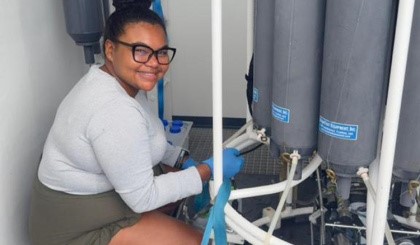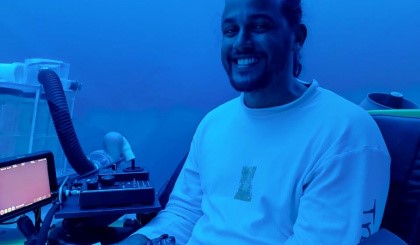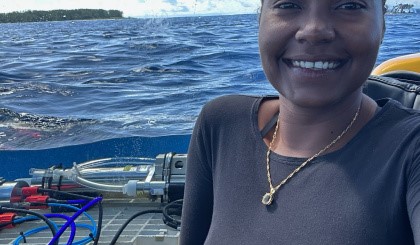Chat with some of the scientists involved in the last OceanX mission |16 February 2024
Seychelles Nation
Unforgettable and unique experience,’ say young Seychellois
Recently, 19 young Seychellois scientists took part in a groundbreaking mission led by OceanX, with the aim of fostering a comprehensive understanding of the Seychelles ocean ecosystem.
This mission was to assess ocean conditions, empower local scientists with knowledge crucial for marine conservation and future climate decisions, and establish new networking opportunities.
For these young Seychellois, this mission represented a rare chance to engage in such a significant scientific exploration.
Seychelles NATION had the privilege to chat with several participants, getting to know their motivation for joining this unique mission, the duration of their involvement, their roles aboard the vessel, and their overall experience.
We explored what it meant to them, as young Seychellois, to be part of such an adventure. In the first part of the series we talk to five scientists and we will bring you the second part in a future edition.
The expedition consisted of two legs – 11 days around Aldabra for the first leg and 13 days for the second leg in the Amirantes.
This OceanX mission was made possible through collaboration with various partners, including Seychelles’ Ministry of Agriculture, Climate Change and Environment, Seychelles Islands Foundation (SIF), Island Conservation Society (ICS), University of Seychelles, Seychelles Fishing Authority (SFA), Islands Development Company, Save Our Seas Foundation – D’Arros Research Centre, Seychelles Conservation and Climate Adaptation Trust (SeyCCAT), and Talma Consultancy.
Priya Didon – 22 years old, works as assistant conservation officer on Desroches island for the Island Conservation Society (ICS).
“I’m an alumni of the University of Seychelles and I joined the expedition through Unisey as the co-leader for Shallow BRUVS along with Mr Laing who was leading the project onboard. I was onboard for both legs, the first in Aldabra and second in the Amirantes group. I could describe my experience onboard OceanX as a knowledgeable and exciting one, surrounded by amazing people with bright minds who were always eager to uncover and question our day-to-day findings as we conducted research around islands or parts of islands that have not been or are rarely explored due to limitations such as lack of scientific equipment, resources or environmental factors.
“OceanX therefore played a major role in enabling and facilitating the research around our islands and our waters. Apart from Shallow-BRUVs I was able to get a taste of the other research being conducted on the vessel and helped the other scientists with their research. This allowed us to gather new knowledge about things that are not always directly in our field of work or that we would otherwise never get the chance to experience again.
“As a young Seychellois this expedition has broadened my interest in marine-related science as I got exposed to various parts of the marine world, from an aerial point of view to the deep sea at 400 metres below sea level. I gained a lot from this trip and it is one that I will forever be grateful for. I hope that other young Seychellois get to be part of such expeditions and develop their abilities in the field of conservation and marine science because there is still so much to do and so much more that could be done. I’ve had a lot of firsts on this trip, from snorkeling with dolphins, observing turtles and sharks from a helicopter, going 400 metres below sea level in a submarine and being part of the historic exploration of the Amirantes Trench at 4,600 metres. I have a lot to be grateful for, for sure! All the knowledge and skills gained will surely benefit my career in conservation.”
Dainise Quatre – 30 years old, fisheries scientist in the research department at the Seychelles fishing Authority
“I was nominated by SFA to take part in the OceanX mission with the aim of co-leading the e-DNA research and also to join in and help with other research projects that would take place on board during the expedition. I participated through the whole expedition. So I was on both legs.
“On board I was co-leading the environmental-DNA research alongside an OceanX expert scientist that specialises in the work of e-DNA and ecological and genetic research. Therefore most of my time onboard was spent in the lab doing loads of amazing scientific work, where I filtered water samples, obtained different materials from samples taken at various depths in the water column and from there extract the DNA from the samples and prepare for sequencing analysis to determine the different species genomes by using a reference library.
“The purpose of the e-DNA research was to conduct a fisheries assessment for SFA and also update the fisheries catalogue of biodiversity within Seychelles.”
“There is no specific word I can use to describe my experience I had onboard the OceanX. Being exposed to these kinds of environmental scientific work has built up my understanding and capacity to another level. This journey is an unforgettable experience that will always have a special place in my heart. I really enjoyed working with the other Seychellois scientists and environmentalists. It was also such a pleasure working with the amazing OceanX scientific, media and crew members. They were all lovely peoples whom I will deeply miss.
“It is such an honour as a young Seychellois to represent our country and also to represent young scientists onboard this amazing research vessel. I want to inspire other young scientists, especially young women scientists to grab hold of such amazing opportunities. I have built up my understanding and skills in e-DNA and genetics research. I had gained the skills on how to collect and extract DNA from water and sediment and knowledge on how to handle different biological samples to prevent contamination.
“The next step will be to share these skills and knowledge with my colleagues at SFA, and incorporate these techniques into my work. I was part of the three first Seychellois to get the opportunity to do the first ever 1,000-metre submersible dive in the Seychelles water. It was such an emotional and out-of-this-world moment which I will treasure for life. I am so grateful to Miss Sheena Talma and the OceanX team for giving us this opportunity to experience the 1,000-metre ocean environment.”
Georgette Savy – 25 years old, project officer at Indian Ocean Tortoise Alliance
“I was nominated by Seychelles Islands Foundation as I was previously working on Aldabra atoll. I joined the second leg of the mission from January 31 to February 11 within the Amirantes group. My duties included helping with the deployment of BRUVs (baited remote underwater video) rigs, data collection and data management. My experience was great. I got to learn more about the marine side of research and got the chance to see what is living within our ocean. This has been a once-in-a-lifetime opportunity. It was an honour to be one of the first Seychellois to have witnessed the ROV (remote operated vehicle) go down to 4,600 metres and to see the abundance of life within our ocean. As I have experience mostly within the terrestrial side of conservation, this mission provided me with some knowledge regarding the marine side of conservation and some methods used to collect data. I am excited to see what comes out of the data collected and hope to work within the marine field eventually.
“I am aiming to hopefully secure a scholarship to study for a post graduate degree in the environment field. My best moment was when I got the chance to go in the Ocean X submersible to 450 metres deep. It was an out-of-this-world experience that I will never forget.”
Sebastian Cowin – 25 years old, field research assistant for SIF, based on Aldabra atoll
“I was nominated by SIF to join the expedition as an opportunity to learn and help with planning activities around Aldabra atoll. I joined the expedition on January 18 until February 11.
“My responsibilities on the vessel was to help with planning of activities around Aldabra and other ongoing projects which included preparations and deployments of rigs as well as data collection.
“It was an incredible experience and an immense learning opportunity. I met like-minded people where information was shared and new skills were learnt. I am very proud to have been part of such an expedition, the data collected shall help demonstrate the importance of conservation especially within areas that have not been well explored. During the expedition, I learned new techniques on surveying certain species and how technology is such an important tool in ensuring the quality and quantity of data collected.
“My best moment was being able to have a firsthand view of the deep sea within the submersible. Being able to explore areas that we have so little knowledge about.
“This expedition has definitely encouraged me to further my career within conservation as there is still so much to learn and understand.”
Dillys Pouponeau – 29 years old, Save Our Seas Foundation – D’Arros Research Centre (SOSF-DRC). She is currently studying with University of Exeter / JICAS (remote MSc)
“I joined the mission through the Save Our Seas Foundation which took part in order to start gathering baseline information on the presence of pelagic species in the Seychelles exclusive economic zone (EEZ) using pelagic BRUVS in different geographically distinct locations. The SOSF-DRC decided to take part as it was a unique opportunity to work with other Seychelles’ NGOs and entities and to gain and apply new skills for its staff. It was a great opportunity as it is quite difficult to access these locations and study the spatial variability of these species. It was also the first application of pelagic BRUVS in Seychelles on that scale using this method, therefore a chance to practice and assess the use of this tool/methodology for such studies. I joined for the second leg which lasted 12 days.
“On the boat, I was the co-lead for the pelagic BRUVS study alongside the programme director of the SOSF-DRC. My duties involved planning, preparing all equipment and leading a team out on a zodiac for deployment of the pelagic BRUVS. At the end of the day, care for the equipment, management of the data (downloading and storage) of both the BRUVS videos and the databases, and ensuring all is set for the next day.
“Working on a research vessel has been on my wish list for a while and I am happy to say that I’ve now had the opportunity to experience it. It not only met my expectations but exceeded it. Most importantly, this experience was a defining milestone for me, showcasing everything I have learned and my abilities. Stepping out of my comfort zone to guide a group of non-experienced scientists in this methodology, teaching them in an unknown location, was quite the experience. Being comfortable in your workplace is one thing, but entering a new environment with new conditions, a new boat, and people unfamiliar with the methodology is something else entirely. It tests you by allowing you to apply all you have learned in a different environment, showing what you are capable of. Plus, the conditions were not the best, so it was a great opportunity to overcome obstacles.
“My most precious moment was definitely going down to 450 metres in the submersible. To see this whole new world you don’t understand until you experience it. I am studying zooplankton back on D’Arros, and I collect them at the surface. Seeing the live plankton illuminating the dark ocean, deep where they originate, sparkling like diamonds in the sky, small fish feeding on them, then bigger fish; seeing that food chain really touched me. I could not hold back my tears, I was so emotional. My second favourite moment would be seeing a blue shark on our pelagic BRUVS and my colleague Ellie getting to see an oceanic manta ray, a thresher shark and a sunfish in her sub experience, at D’Arros and St Joseph, all for the first time. Although I was not the one who experienced it, it brings me joy to see the diversity and life of the surrounding ocean where I live and work.
“As a co-lead, it meant that the team/study leaders would switch and take turns leading deployments, allowing each of us to experience other research and departments on the boat. In addition to the pelagic BRUVS, I had the opportunity to take part in aerial marine mammal surveys (in the helicopter), deep sea survey using ROV, and shallow BRUVS. I also briefly observed what was happening in the lab and in the media department. So it was a great learning experience for me. Also, just being in a group of scientists was excellent. Networking is essential for scientists. Meeting scientists and sharing knowledge allow us to inspire and learn from each other. It certainly helps to keep up to date with what is going on with the research both in the country and in the world. Overall, everything I learned will definitely help me in every aspect of my career as a scientist and in the work that I do.
“It is not something that you can just pay to experience like going on a scuba dive trip. Not many people get the chance, especially to these depths. Being one of the few is such a privilege, truly. And being on the boat, I was surrounded by some amazing young scientists excelling in their field. Seeing the youth leading the projects was thrilling. Safe to say Seychelles is doing so well and the future looks bright for all of us. Kudos to all of us, and congratulations to the organisers.”
Compiled by Vidya Gappy






Leave A Comment